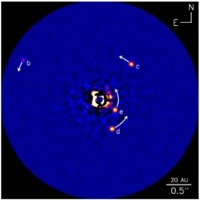Astronomers discover, image new planet in planetary system very similar to our own
30 Dec 2010
An international team of astronomers has discovered and imaged a fourth giant planet outside our solar system, a discovery that further strengthens the remarkable resemblances between a distant planetary system and our own.
 The research is published 8 December in the advance online version of the journal Nature.
The research is published 8 December in the advance online version of the journal Nature.
The astronomers say the planetary system resembles a supersized version of our solar system.
"Besides having four giant planets, both systems also contain two 'debris belts' composed of small rocky or icy objects, along with lots of tiny dust particles," said Benjamin Zuckerman, a UCLA professor of physics and astronomy and co-author of the Nature paper.
Our giant planets are Jupiter, Saturn, Uranus and Neptune, and our debris belts include the asteroid belt between the orbits of Mars and Jupiter and the Kuiper Belt, beyond Neptune's orbit.
The newly discovered fourth planet (known as HR 8799e) orbits a bright star called HR 8799, which lies some 129 light years from Earth and is faintly visible to the naked eye. The mass of the HR 8799 planetary system is much greater than our own. Astronomers estimate that the combined mass of the four giant planets may be 20 times greater than the mass of all the planets in our solar system, and the debris belt counterparts also contain much more mass than our own.
The new planet joins three previously discovered planets that were the subjects of a 2008 paper in the journal Science reporting the first-ever images of a planetary family orbiting a star other than our sun. Four of the co-authors of the new Nature paper, including Zuckerman, were also co-authors on that Science paper.






















